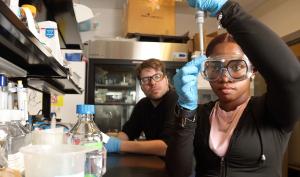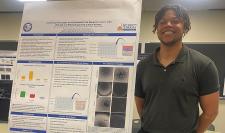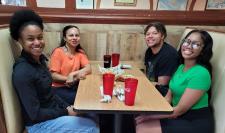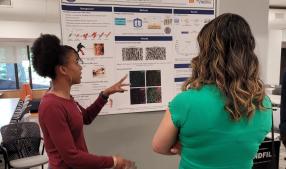Caliari’s lab designs biomaterials that mimic human tissues to study how cells interact with their environment and uses these platforms to address health challenges such as treatment of fibrotic diseases or repair and replacement of musculoskeletal tissue.
Pearson, a Richmonder starting her fourth year at Hampton, reunited with Jonathan Florian, a graduate student in associate professor KYLE LAMPE’s biomaterials research group. For her project, “Annealing and Sonicating Self-Assembling Peptide Hydrogels Impact Mechanical Properties,” she studied hydrogels — water-swollen, gelatin-like materials — designed to be compatible with human tissues and to have the ability to change states from solid to liquid and back again.
The Lampe lab focuses on biomaterials and tissue engineering for medical applications such as treating nerve or brain injuries. The gels Pearson worked on are designed to flow through a needle and then form a gel again — meaning they can potentially be used to deliver healthy cells to repair injured tissue by injection.
Tyson, a fourth-year student from Nashville, Tennessee, completed his second internship with assistant professor Lakeshia Taite but it was his first time working with Ph.D. student Samuel Agro. Tyson’s project, “Tuning PEGDA Hydrogel Stiffness to Support Adhesion and Organization of Vascular and Pancreatic Ductal Adenocarcinoma Cells,” involved growing human cells on hydrogels of varying stiffnesses to compare how the gels’ mechanical properties affected the cells’ behavior.
Taite’s lab designs hydrogels with functional properties capable of promoting new growth of soft tissues such as blood vessels. Her team can tune the gels to mimic different properties of human tissue, such as stiffness and elasticity.
Tissue stiffening occurs with the progression of diseases such as fibrosis, or scarring, and cancer. By growing cells in or on hydrogels in which the degree of stiffness is controlled, researchers can observe the cells’ response to their environment. This fundamental science is key to understanding how diseases progress and potential paths to treating them, such as through targeted drug delivery or tissue regeneration.
Taite, Lampe and Caliari are part of a community of researchers at UVA Engineering and in the School of Medicine who are breaking new ground in tissue engineering and biomaterials systems for research to address difficult challenges in medicine.
Hampton’s chemical engineering department is small, but it propels a lot of its graduates into Ph.D. programs, Jerald Dumas, former chair of chemical engineering at HU, told UVA Engineering last year. Partnerships such as the UVA internship are largely to thank for that, Dumas said at the time.
That track record motivated William Epling, the Ann Warrick Lacy Distinguished Professor and chair of UVA chemical engineering, to support creating the program in 2022.
“We’re always looking for excellent graduate students, and Hampton has been a source of excellent graduate students to other universities,” Epling said. “We’re showing them UVA is a great option and hope to attract them to join us here.”



